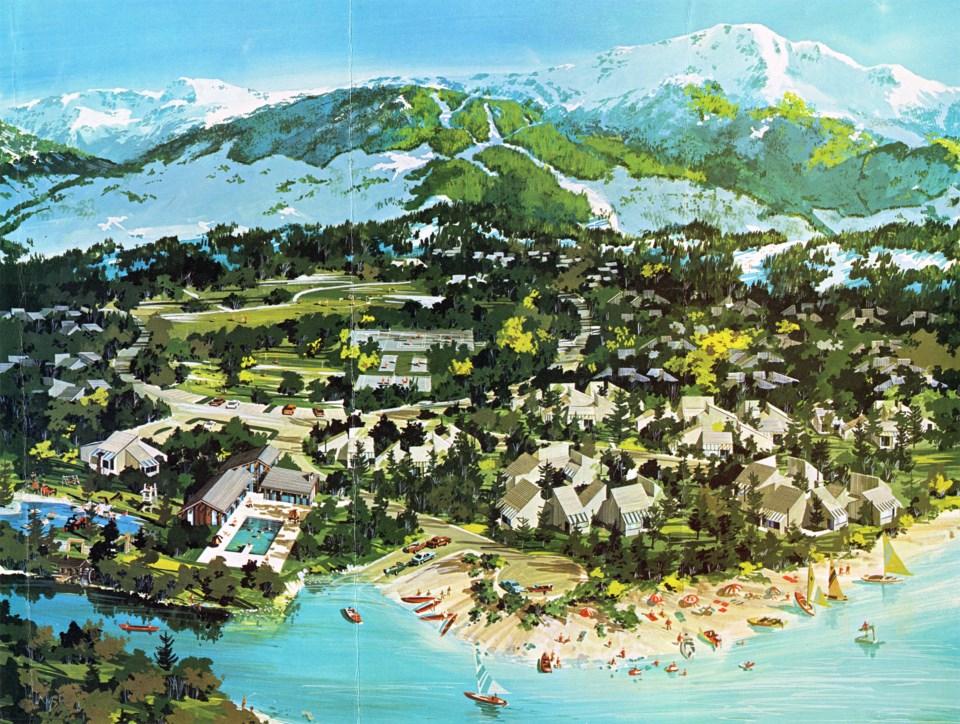When we hear stories about Adventures West at the Whistler Museum, most of them tend to centre on the Keg Restaurant and the memorable hours that people spent there. The restaurant, however, was just one part of a much larger plan for the area that began development in the early 1970s.
Construction began on the Adventures West Village (AWV) development in mid-September 1971, though planning started much earlier. According to a 1972 article in The Vancouver Sun, Richard Street and Alta Lake Ltd., the company that was developing Adventures West, spent years researching the Alta Lake area and potential markets before taking seven months to select the site for the project. They reportedly chose the 52 acre site at the north end of Alta Lake because of its location along the shore of Alta Lake and the banks of the River of Golden Dreams. Finally, they drew up plans and started the first phase of the proposed $5 million complex (just under $40 million today when adjusted for inflation).
The original plans for AWV were grand, including 250 condominium units, a playpark for children, sports fields, tennis courts, a swimming pool, beach, boat harbour, novice ski hill, toboggan chutes, skating ponds, snowmobile course, and the Adventure Inn, which would include a sports shop, equipment rentals, “groceteria,” bar, lounge, and administrative offices. The first phase, which they expected to have completed by December 1971 and operational in January 1972, included the first 30 units, utilities and roads, and the ski hill, beach and playpark. The rest of the units and facilities were planned to be constructed over the following three years.
Its affordability was one of the main selling points featured in articles and advertisements for AWV. The tagline on a promotional booklet proclaimed it as “the possible dream” and claimed that “Adventures West condominiums are the complete family vacation home package…offering carefree vacation living at low cost.” Along with low purchase prices beginning at around $12,000 (about $96,000 today), AWV offered a rental program that owners could choose to take part in to recoup some of the cost. AWV would handle all of the administration, supplies, marketing and cleaning and units would be rented out while not in use by the owners; revenue would be split between the company and the owner.
The first units of Phase I were completed on schedule and available for owners and visitors in early 1972. To encourage mid-week visitors, AWV, like quite a few of the lodges in the ski area, offered a ski-week package. For $75, the ski-week included five nights accommodation at AWV, lift tickets for Whistler Mountain, two meals each day, transportation to and from the ski hill, and après ski activities such as a wine-cheese-pizza party, singalongs and moonlight snowmobiling, all kicked off on Sunday night with a “get-acquainted party” open to guests and Alta Lake residents. Jim McConkey, who ran the ski school at the time, would even make an appearance at these parties with some of his ski instructors. They would show ski films and answer any questions guests might have. A $65 ski-week was almost the same, except that the ski days were divided between Whistler Mountain and the small novice ski hill beside AWV.
Adventures West’s location on Alta Lake also made it a popular summer option and in 1972 it also began serving as the accommodation for the Toni Sailer Summer Ski Camps, which had previously been housed at the Highland Lodge, Cheakamus Inn and Christiana Inn. Though the development was not complete, they had built a beach area from which campers and other guests could go swimming, windsurfing, and more. As a resort, AWV offered various summer excursions, including trail rides up Rainbow Mountain, lift rides up Whistler Mountain and lunch at the Roundhouse, and boating down the Green River.
Over the next few summers, AWV announced plans to build more units and some of the other promised features, such as the boat harbour and swimming pool, as part of Phase II. The Adventure Inn building opened in the summer of 1974, including Whistler’s first Keg ‘N Cleaver restaurant. While some more units were built, the entirety of the AWV development was never realised.
The creation of the Resort Municipality of Whistler in 1975 and the subsequent planning of the Whistler Village focused development at the base of Whistler and Blackcomb Mountains and over time the rest of AWVs 52 acres were sold off. In May 1981, the Keg building was broken into three parts and moved to its current location on Blackcomb Way, where it still serves today as Municipal Hall.




